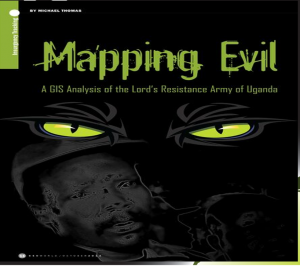
Originally Published in the October 2012 Issue of GeoWorld (https://read.dmtmag.com/i/91181-geoworld-october-2012/1?m4=)
The night is quiet. The family is asleep and all is seemingly peaceful. Unfortunately, evil is almost within reach of them and when it touches this family in Central Africa none of their lives will ever be the same. Before the night is over, they will all be awakened, the children will witness the murder of their parents, the burning of their village and all the children of the village will be marched at gunpoint into the bush perhaps never to be seen again – until they have been brutalized and become puppets of evil performing the same atrocities on the next set of victims.
These are the tactics of the Lord’s Resistance Army – the LRA. The Lord’s Resistance Army is led by Joseph Kony, an ethnic Acholi (Uganda) from northern Uganda. The group’s ideology and objectives are vague – they have pledged to rule Uganda by the Bible’s Ten Commandments. The group uses terror to induce fear and control over civilians and amasses supplies and personnel (child soldiers and sexslaves) by attacking villages. In 2005, military pressure forced the LRA out of Uganda and while now in “exile” they operate primarily in the NE Democratic Republic of the Congo (DRC), south Sudan and the Central African Republic (CAR). These regional governments lack the ability to maintain security in LRA afflicted areas and when combined with the remoteness of the area, allows the LRA to continue to demonstrate the ability to survive in this inaccessible region.
Transient populations are often associated with regional conflicts and are referred to as internally displaced persons (IDPs). Predicting them ahead of time is difficult if not impossible. The populations of remote places in Central Africa are often vulnerable and as a result often victimized. Is it possible to use available data in a manner similar to local law enforcement to predict what may be the next course of action (COA)? The answer is yes. I attempted in September 2011, to document and analyze using spatial statistics, the activities of the Lord’s Resistance Army (LRA) in the period of 2009-2011. This analysis is derived from geospatial, unclassified open source intelligence that include open source press statements, academic journals and articles, and international and NGO databases. A successful prediction was actually made. Many in the world are now aware thanks to the phenomena of the Kony 2012 video that went viral in March of 2012, but there were always a few that always knew and struggled to make the world realize what was happening.
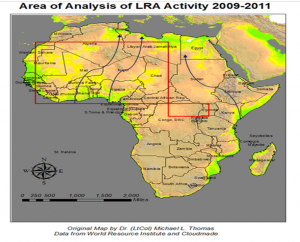
Figure 1. Africa is a huge landmass that could easily contain much of the rest of the world’s land areas with room left over. The large red box above depicts an area that could contain the lower 48 of the US. The smaller red box is the area of our analysis. We will refer to this area as the Tri-Border region. The smaller red box is the Area of Operations (AO) of the LRA. As depicted it is approximately 125,000 square miles but fluctuates as attacks occur. For comparative purposes the total area of California is 158,706 square miles. So the AOI bounded by the smaller red box is approximately the size of the state of California. The blue arrows represent traditional trade and smuggling routes. This is important because if it’s hard to get goods thru or to an area, it’s hard to get help, aid and assistance in. This contributes directly to the longevity of the LRA since these routes bypass their AO.
When one considers issues in Africa if you don’t consider the aspects of geography you are doomed to fail with whatever efforts you attempt to make on any issue – humanitarian or otherwise. We first have to begin with a basic understanding of the scope of the problem based on such geographic factors as size and the difficulty of access to areas that lack basic infrastructure such as roads and communications. Africa is over 30.3 million square km. Combined, the lower 48 of the US, India, Argentina, Western Europe, the British Isles and China make up just 29.8 million square km, so, these entire landmasses could be fitted into the boundary of the continent with 500k square km to spare.
The area the LRA operates within comprises one of the poorest and most isolated areas of the world – both factors that contribute to the longevity of the LRA. Roads and communication in the LRA’s area of operation are severely degraded, hindering international and regional trade. While al-Qaida affiliates, such as AQIM, rely on major trade routes and smuggling networks for facilitation, day-to-day sustainment, and operational movement, these major trade routes are not a supporting factor for the LRA. Inaccessibility in this area leaves villages cut off from security and humanitarian services and creates the circumstances that allow the LRA to take advantage of them for recruits and logistical support. In mid-March and early May 2011, elements of the LRA transitioned to CAR, and their attacks have left at least scores dead, 10,000 displaced, and 411 people fleeing to the DRC.
The LRA is a major factor of regional instability in the area between northeastern DRC, northern Uganda, south Sudan and CAR. In December 2008, the Ugandan Army launched “Operation Lightning Thunder” aimed at hunting down Joseph Kony and destroying the LRA military capabilities, but the result was that the LRA became even more regionalized with continuous foraging movements of smaller cells between each of the three countries in the tri-border region. Today, the majority of LRA ground force is comprised of child soldiers, with some estimating the number around 80% of the total strength of the force.
Uganda’s description of the Lightening Thunder operation in 2008, as being a success ignores the secondary effects it has had on destabilizing the entire region. The Ugandan government characterizes the LRA as a “causeless and homeless group” and it’s position it that is has killed or captured more than 350 LRA fighters and states there are only about 200 remaining. By the LRA’s fluid nature, it’s very difficult to determine who is a fighter and who is not (child soldiers or slaves?). The LRA is constantly kidnapping villagers, killing many and training others to become fighters while keeping still others – women and girls in particular – as laborers and sex slaves. One question is hard to answer – with thousands abducted, what have become of the majority if the count is now actually down in the few hundreds as the Ugandan government maintains? Is it possible using GIS methods to detect patterns in the attacks that can provide estimates of the numbers of groups and the high probability areas of where the next attacks might occur?
While it is a remote area, it is not completely unknown. The tri-border region between DRC, Sudan, and CAR share one predominant ethnic identity and language – Azande. A shared culture and frequent intermarriage result in continuous cross-border movement throughout the region and so it is a perfect example of an “ungoverned space.” The religion among the Azande is historically animist blended with modern-day Christianity, but on the whole they are deeply superstitious – and this factor plays into the psyops practiced by the LRA. Subsistence agriculture remains the backbone economic activity of the region.
The word Azande means “the people who possess much land”, and refers to their history as conquering warriors. The Azande land is tropical rain forest that enjoys high annual rainfall. This makes it a an area with a very high agricultural potential. The Azande are subsistence farmers and grow food crops such as maize, cassava, and mangoes etc. http://www.gurtong.net/Peoples/PeoplesProfiles/Azande/tabid/179/Default.aspx. This contributes to making a target of convenience for LRA. Their tribal region extends all through the tri-border area. They speak Zande, which they call Pazande in their own tongue. It is an Adamawa-Ubangi derived language. They have been traditional small-scale farmers and settled land owners, raising only chickens until the 1980s; but now they also include goats and pigs. Their traditional beliefs in magic and witchcraft, known as ‘mangu’, are strong. Several near-daily rituals exist that focus on protection from or canceling out the powers of witchcraft. Although non-government organizations (NGOs) do frequent these areas, the remoteness of the location, lack of security, and LRA attacks make it difficult and dangerous to establish a presence for humanitarian aid or even quick response from military forces.
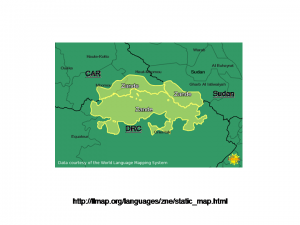
Figure 2. Range of the ethnic language group of the Azande – the primary group in the tri-border region and the main targets of the LRA – currently. From http://llmap.org/languages/zne/static_map.html accessed on 21Aug2011.
An NGO organization in Norway maintains the primary source of attack/event data used in my pattern analysis. The Armed Conflict Location and Event (ACLED) Dataset is maintained by the Center for Conflict Studies in Oslo. The dataset encodes location data of all reported conflicts in 50 countries in the developing world and the LRA is prominent among the perpetrators of violence in attacks spanning over 25 years. The data are derived from a variety of open sources and can be used in any GIS mapping program.
In Figure 3, the results of a Kernel Density Estimate (KDE) are displayed. Two areas and two different contrasting patterns emerge on examination of this map. There seem to be two distinct clusters associated with two separate Conservation areas, one being the Garamba National Park located on the south Sudan-NE DRC border and one located contiguous to a second area that stretches along the northern DRC-southern CAR border. What also might facilitate the movement of the LRA is the presence of a road or a trail, that allows for quick access to and egress from an event area. While the roads are not good enough to allow for quick response by either Sudanese, CAR, DRC or UPDF (Ugandan Peoples Defense Forces) forces and their associated heavy equipment, they are good enough to allow a small mobile tactical force armed only with light weapons like the LRA freedom and ease of movement in and out of their hiding areas inside the protected and heavily forested areas. The populated places expressed in Figure 3, come from the CIESEN database of Columbia University.
So while this analysis is interesting is it of itself useful? Given the sheer size of the area, the lack of infrastructure and the lack of resources to combat the LRA combined with 3 countries whose attitudes towards each other can sometimes be contentious, the answer would seem to be no, but there is a pattern of movement that may be of some use. The analysis should ideally be in support of a group engaged in the hunt for the LRA, or analysis by itself satisfies little. When examining the various incidents over time, activity seemed to be focused in the NE DRC in 2009, and move westward along the CAR DRC border in 2010. The data published by the UN for the first half of 2011, indicated attacks moved back eastward in the NE DRC region. They have since moved into CAR as well.
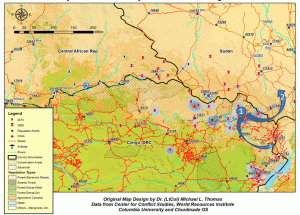
Figure 3. KDE analysis of the tri-border region. The bulk of the attacks seem co-located near what roads there are and protected conservation areas. Combined these two features provide quick access to populated areas from the heavily forested areas, such as Garamba National Park, on the border with south Sudan. It provides ample areas for cover and concealment after an attack against a local population has taken place. This is confirmed by a visual inspection of a similar map produced by the Enough project, an NGO whose homepage is www.enoughproject.org .
Assessments and Recommendations.
The LRA is a unique threat that occupies a large area spanning three borders in Central Africa. The LRA is able to take advantage of political and geographic terrain that hinders both regional and international cooperation. Furthermore, the LRA remains a significant challenge to humanitarian aid due their high mobility and capability to carry out sudden attacks in an unsecure region.
- The dramatic increase in IDPs throughout Orientale Province (DRC) is directly attributed to the persistent state of insecurity caused by LRA presence. Humanitarian access to affected populations remains difficult due to poor security conditions and minimal paved road infrastructure.
- Based on vegetation pattern data from the World Resource Institute, it seems that the most highly correlated factor associated with LRA presence in an area is dense forest. However, the other factors that appear to primarily attract LRA activity are related to population – they need a supply of “labor”. These populated places provide logistical support in the form of food, supplies, and labor from the traditional farmers. Things that are repellant factors are lacking in my assessment, because the LRA is a reactionary group that moves quickly in response to the changing environment, such as transient populations and military operations.
- One recommendation would be for improved intelligence sharing among all regional partners to provide consistent information and to improve cross-border coordination, which would further aid security and humanitarian assistance. The problem with this is the fact that many of the regional partners have issues with each other (i.e. Uganda’s 1990’s invasion of DRC and water disputes between Uganda and Sudan over water rights on the Nile River) and may not be able to cooperate to the degree necessary.
- Another recommendation would be better mapping of IDP camps and the movement of populations within the camps which could result in improved future analysis that supports and better directs future security and humanitarian efforts in the region.
- The construction of a major road in the region would significantly open up remote areas and give easier access to security and humanitarian aid in susceptible areas. What hinders response time by both humanitarian NGOs and security response forces from the 3 nations is also a supporting factor for the LRA.
- Improved telecommunications in the region could shorten security and aid response time. An HF network is being established by Catholic missionaries incrementally in DRC as funding is available (see Figure 4). This was identified as a strategy by Catholic missionaries in their plan Invisible Children Protection Plan. The increased HF radio network would be used an early warning mechanism. Analysis of this type of data would allow for partners to provide equipment to fill in gap areas with no coverage. Security force monitoring would allow for a quick response to get moving if an appeal for help went out. Coordination of efforts using all available resources could drastically diminish the LRA’s ability to function. There is a significant lack of diverse and continuous data available for this AOI. What data is available, especially from NGOs, tends to be fragmented, compartmentalized, difficult to acquire and in multiple formats with varying degrees of accuracy and timeliness.
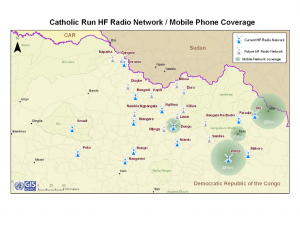
Figure 4. HF radio network being implemented by the Catholic church in NE DRC. From https://salsa.democracyinaction.org/o/2241/images/FINAL_From%20Promise%20to%20Peace_Resolve%20Publication.pdf. Accessed on 26Aug2011. Locations of the stations is not available online – an example of data being held at the local level or by NGOs with no central repository. Availability of data and coordination of efforts would greatly enhance counter LRA efforts.
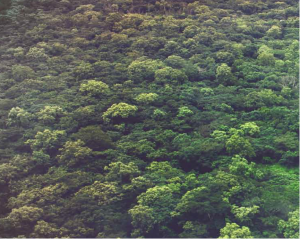
Figure 5. Typical vegetation – triple canopy jungle in NE DRC . From http://c2052482.r82.cf0.rackcdn.com/images/383/original/Protection_Plan.pdf The thickness of the canopy provides cover and concealment for movement on the ground without any risk of being detected from overhead.
Problems and shortfalls that work to the advantage of the LRA.
In May 2010, the UN issued Security Council resolution 1925 which ordered MONUSCO o support “ongoing military operations to completion,” and included provisions for protecting Congolese civilians, while resolution 1812 from 2008, orders UNMIS to effectively do the same in Sudan – both issued independently to the 2 missions and without coordination.There is a persistent lack of data across the whole AOI including, but not limited to, populated places, infrastructure, communications towers, detailed terrain features, available healthcare, illness, weather trends, schools, criminal activity, and economic statistics.
There is a lack of both inter and intraagency cooperation – even hubs of the UN OCHA and the UNHCR do not necessarily have data from each local office within their respective AOIs, and what data exists at the local level is not kept in a centralized location. Another example is the dual UN missions of MONUSCO in the DRC and UNMIS in Sudan – although they are under the same umbrella organization, there is no combined chain of command nor is there a mandate to share data and resources outside their respective mission areas.
- There is a lack of data at the strategic level. More detailed data exists at the village, district, or provincial level, but only when you know exactly what you are looking for, i.e., the name of the IDP camp or the NGO holding the data (see Figure 4 – Catholic Run and Operated HF Net).
- Approaching this topic year by year has proven difficult due to rapid movement of the LRA. The statistics frequently change dramatically from one month to the next.
- Available data was often not “timely” enough. Comprehensive reports that address a strategic overview are often not available until a year later after events occur. For example, the UNHCR’s Statistical Yearbook for 2010 was not be available until December 2011. Another example – the ACLED DB was is always several months out of date and the update cycle is infrequent.
- There is a plan in place to attempt to ameliorate this with social media and a website sponsored by the “Invisible Children” organization. They have a website at http://lracrisistracker.com that advertises what is a near real time tracking capability as events occur. Provided the security forces, the missionaries in the region and other NGOs coordinate their event reporting, the data access and the response, better data might be turned into actionable intelligence more quickly possible than in prior years.
There are other real issues pending for a successful eradication of the threat – the main one currently being political. There are conflicting priorities between partners in the region – one surprising one being between Uganda and the US. Congress and the administration have taken strides to garner together a regional strategy. The “Lord’s Resistance Army Disarmament and Northern Uganda Recovery Act,” was signed into law in May 2010, and requires the US government develop a regional strategy to eliminate the LRA threat. At odds with this is the announcement by the Ugandan government to remove 700 of its forces from the fight and declaring that the LRA is no longer a threat to the state of Uganda. “[The LRA] is not a threat to Uganda – not at all,” Felix Kulayigye, spokesman for the Uganda armed forces, told IWPR on 17Aug2011.” Taken from http://iwpr.net/report-news/war-lra-rebels-loses-momentum on 22Aug2011.
This may be premature given the evidence of an easterly movement of activity back towards Uganda and be a result of US influence on Uganda to supply more troops to the AU Mission in Somalia (AMISOM). While the data available for analysis does not lend itself to make an exact prediction of the LRAs next movement although it is possible to speculate possible Courses of Action (COAs) that might be executed by the LRA. With KDE the LRA was seen to be moving back from the west, the question became one of 3 Courses of Action (COAs) for them (see Figure 13):
- Maintain a presence in the Garamba National Forest and take the time to re-equip and rearm
- Move into Southern Sudan and exploit the political situation there or
- Move back into Uganda and re-initiate the process of attempted insurrection there.
Current reports have placed the LRA in CAR and having executed COA 2 as predicted in September of 2011. The popularization of the issue in the world’s media (the video Kony 2012) have given attention to Kony that he has never had previously. While the criticism of the citizens of Uganda have to be respected, it is this visibility of the issue in the media that essentially empowers agents of change to gain traction and finally accelerate the demise of the LRA. “Fame” for such a set of events that long went ignored have now give politicians the support of the people to do something – even for a nation weary of war.
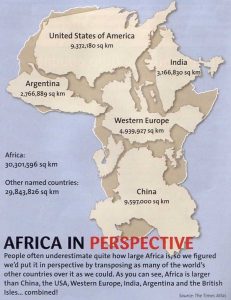
Figure 6. Africa is truly an enormous landmass compared to the rest of the world. http://african-dawn.blogspot.com/2010/10/africa-according-to-worldand-in.html
Bibliography
- No Author.(Apr2011). “Central African Republic: Lord’s Resistance Army (LRA) Activities(1Jan2010 – 16Mar2011)” Accessed from http://reliefweb.int/node/394853 (UN Office for the Coordination of Humanitarian Affairs) on 21Aug2011.
- No Author. (Jul2008). “Lord’s Resistance Army” Accessed from http://reliefweb.int/node/390459 on 21Aug2011.
- No Author. (Apr2011). “LRA Regional Update: DRC, CAR and south Sudan – January-March 2011.” Accessed from http://reliefweb.int/node/394853 (UN Office for the Coordination of Humanitarian Affairs) on 21Aug2011.
- Scott, Lauren M. PhD; Rosenshein, Lauren MS; Janikas, Mark V. PhD (July 2011). “Spatial Pattern Analysis: Mapping Trends and Clusters,” Accessed from esriurl.com/spatialstats (Esri International User Conference, San Diego, CA, Technical Workshops, July 2011). on 21Aug2011.
- No Author. (Jun2011) “LRA Regional Update: DRC, CAR and southern Sudan: April – May 2011.” Accessed from http://reliefweb.int/node/423464 on 21Aug2011.
- Kamandji, Guy-Marin. (June 13th, 2011). “Against the LRA in Uganda, CAR, DRC, South Sudan: Religious leaders call for negotiations, a regional brigade, an increasing humanitarian assistance and the arrest of his supporters.” Press Release No. 007-CC-2011. http://reliefweb.int/sites/reliefweb.int/files/resources/Full_Report_1227.pdf UN Office for the Coordination of Humanitarian Affairs. Accessed on 21 Aug2011.
- USAID Factsheet (May 2011). “Central African Republic – LRA-Related Displacement.” Fact Sheet #1, Fiscal Year (FY) 2011 Accessed on 21 Aug2011 from http://reliefweb.int/node/401330.
- No Author. (14 Mar 2011). “DRC Upsurge in LRA Attacks against civilians in Congo” Accessed on 21 Aug2011 from http://reliefweb.int/node/391851 (UN Office for the Coordination of Humanitarian Affairs).
- OXFAM Briefing Note. (28July 2011). “We are entirely exploitable – The lack of protection for civilians in eastern DRC.” Accessed on 21 Aug2011 from http://reliefweb.int/sites/reliefweb.int/files/resources/Full_Report_1857.pdf oxfam.org
- Pham, Phuong; Vinck, Patrick; Stover, Eric (06-01-2007). “Abducted: The Lord’s Resistance Army and Forced Conscription in Northern Uganda” Accessed on 21 Aug2011 from http://escholarship.org/uc/item/7963c61v#page-38 Reports, Human Rights Center, UC Berkeley.
- Africa Report N°157 (28 April 2010). “LRA: A REGIONAL STRATEGY BEYOND KILLING KONY.” Accessed on 21 Aug2011 from http://www.crisisgroup.org/~/media/Files/africa/horn-of-africa/uganda/157%20LRA%20-%20A%20Regional%20Strategy%20beyond%20Killing%20Kony.pdf CRISIS GROUP REPORTS.
- Hammond, Guy (May 24, 2011). “Eliminating the Lord’s Resistance Army Once and for All.” Accessed on 21 Aug2011 from http://www.stimson.org/spotlight/eliminating-the-lords-resistance-army-once-and-for-all Washington, DC: The Stimson Center, Spring 2011.
- Kelly Max (2010), “Protecting Civilians: Proposed Principles for Military Operations,” Accessed on 21 Aug2011 from http://www.stimson.org/books-reports/protecting-civilians-proposed-principles-for-military-operations/. Washington, DC: The Stimson Center, spring 2010.
- Norwegian Refugee Council (2011). “Internal Displacement in Africa.” Accessed from http://www.internal-displacement.org/publications/global-overview-2010-africa.pdf on 22Aug2011.
- Cakaj, Ledio (2010). “This is our land now – Lord’s Resistance Army attacks in Bas Uele, northeastern Congo.” Accessed from http://www.enoughproject.org/files/publications/thisisourlandnow.pdf on 22Aug2011.
Data Sets Downloaded for the GIS Analysis
- http://downloads.cloudmade.com/africa/northern_africa/sudan/sudan.shapefiles.zip
- http://downloads.cloudmade.com/africa/northern_africa/sudan/sudan.img.zip
- http://downloads.cloudmade.com/africa/eastern_africa/uganda/uganda.shapefiles.zip
- http://downloads.cloudmade.com/africa/eastern_africa/uganda/uganda.img.zip
- http://downloads.cloudmade.com/africa/middle_africa/democratic_republic_of_the_congo/democratic_republic_of_the_congo.shapefiles.zip
- http://downloads.cloudmade.com/africa/middle_africa/democratic_republic_of_the_congo/democratic_republic_of_the_congo.img.zip
- http://www.wri.org/publication/interactive-forest-atlas-democratic-republic-of-congo
- http://www.wri.org/tools/atlas/map.php?maptheme=drcforest
- http://downloads.cloudmade.com/africa/middle_africa/central_african_republic/central_african_republic.shapefiles.zip
- http://downloads.cloudmade.com/africa/middle_africa/central_african_republic/central_african_republic.img.zip
- http://www.acleddata.com/documents/ACLED_COUNTRIES(2011)/UGANDA.zip
- http://www.acleddata.com/documents/ACLED_COUNTRIES(2011)/DRC.zip
- http://www.acleddata.com/documents/ACLED_COUNTRIES(2011)/CENTRAL_AFRICAN_REPUBLIC.zip
- http://www.acleddata.com/documents/ACLED_COUNTRIES(2011)/SUDAN.zip
- http://www.wri.org/publication/interactive-forest-atlas-democratic-republic-of-congo
- http://www.wri.org/stories/2011/02/new-interactive-atlas-will-help-democratic-republic-congo-manage-forests
- http://www.wri.org/tools/atlas/map.php?maptheme=drcforest (Vegetation layers)
- http://llmap.org/languages/zne/static_map.html (Azante details)
- http://sedac.ciesin.columbia.edu/gpw/global.jsp?file=grumpv1&data=ppoints&type=shp&year=2000 (Settlements)
- http://www.ciolek.com/OWTRAD/DATA/tmcDZm1300b.html#top
- http://en.wikipedia.org/wiki/File:Niger_saharan_medieval_trade_routes.PNG
Thank you, I have recently been looking for info about this subject for ages and yours is the best I have found so far.
Thanks for the helpful posting. It is also my opinion that mesothelioma has an particularly long latency period, which means that warning signs of the disease won’t emerge until 30 to 50 years after the original exposure to asbestos fiber. Pleural mesothelioma, that’s the most common sort and influences the area round the lungs, will cause shortness of breath, upper body pains, along with a persistent coughing, which may cause coughing up blood vessels.
Thanks for the guidelines shared on your own blog. Something also important I would like to convey is that losing weight is not about going on a celebrity diet and trying to get rid of as much weight as you can in a couple of weeks. The most effective way to burn fat is by taking it slowly and gradually and using some basic tips which can allow you to make the most through your attempt to lose weight. You may recognize and already be following many of these tips, yet reinforcing expertise never affects.
The very crux of your writing while sounding reasonable in the beginning, did not really sit well with me personally after some time. Someplace within the paragraphs you were able to make me a believer but just for a very short while. I however have got a problem with your jumps in logic and you would do nicely to help fill in those gaps. When you actually can accomplish that, I could surely be impressed.
I love your blog.. very nice colors & theme. Did you make this website yourself or did you hire someone to do it for you? Plz respond as I’m looking to construct my own blog and would like to find out where u got this from. many thanks
Valuable info. Lucky me I found your website by accident, and I am shocked why this accident didn’t happened earlier! I bookmarked it.
Whoa! This blog looks exactly like my old one! It’s on a completely different subject but it has pretty much the same page layout and design. Excellent choice of colors!
Great website! I am loving it!! Will be back later to read some more. I am bookmarking your feeds also.
Amazing blog! Do you have any tips and hints for aspiring writers? I’m planning to start my own blog soon but I’m a little lost on everything. Would you suggest starting with a free platform like WordPress or go for a paid option? There are so many options out there that I’m completely confused .. Any suggestions? Thanks a lot!
It抯 really a nice and useful piece of info. I抦 glad that you shared this useful information with us. Please keep us informed like this. Thanks for sharing.
I’m really enjoying the theme/design of your website. Do you ever run into any browser compatibility issues? A small number of my blog readers have complained about my blog not operating correctly in Explorer but looks great in Opera. Do you have any suggestions to help fix this issue?
I discovered your blog website on google and examine a couple of of your early posts. Proceed to keep up the superb operate. I just further up your RSS feed to my MSN Information Reader. Searching for forward to studying more from you later on!?
Thanks for your publication on this site. From my own experience, many times softening right up a photograph may provide the professional photographer with an amount of an inspired flare. More often than not however, the soft cloud isn’t exactly what you had planned and can usually spoil a normally good image, especially if you thinking about enlarging this.
Way cool! Some very valid points! I appreciate you penning this post plus the rest of the site is also very good.
Have you ever thought about including a little bit more than just your articles? I mean, what you say is valuable and all. However imagine if you added some great visuals or videos to give your posts more, “pop”! Your content is excellent but with pics and clips, this site could certainly be one of the best in its field. Superb blog!
Thanks for the several tips shared on this blog. I have noticed that many insurance carriers offer clients generous discount rates if they decide to insure several cars together. A significant number of households own several cars these days, specially those with more mature teenage young children still living at home, and also the savings in policies can certainly soon mount up. So it makes sense to look for a great deal.
Excellent blog here! Also your site loads up very fast! What host are you using? Can I get your affiliate link to your host? I wish my web site loaded up as quickly as yours lol
Good post however I was wondering if you could write a litte more on this topic? I’d be very grateful if you could elaborate a little bit more. Cheers!
You could definitely see your skills within the work you write. The world hopes for even more passionate writers such as you who are not afraid to say how they believe. All the time follow your heart.
That is very attention-grabbing, You are an excessively professional blogger. I have joined your feed and sit up for seeking more of your magnificent post. Additionally, I’ve shared your website in my social networks!
Thanks for making me to obtain new strategies about personal computers. I also contain the belief that one of the best ways to maintain your notebook computer in perfect condition is with a hard plastic-type case, or shell, that will fit over the top of your computer. A lot of these protective gear usually are model specific since they are made to fit perfectly across the natural housing. You can buy these directly from the seller, or from third party places if they are intended for your notebook computer, however only a few laptop can have a shell on the market. All over again, thanks for your recommendations.